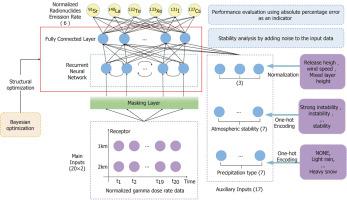Journal of Hazardous Materials ( IF 12.2 ) Pub Date : 2021-02-26 , DOI: 10.1016/j.jhazmat.2021.125546 Yongsheng Ling , Qi Yue , Tian Huang , Qing Shan , Daqian Hei , Xiaojun Zhang , Wenbao Jia

|
When severe nuclear accidents at nuclear power plants release radioactive material into the atmosphere, the source term information is typically unknown. Estimating the emission rate of radionuclides is essential to assess the consequences of the accident before adequate decision-making can be performed. A recurrent neural network-based model, optimized with the Bayesian method, is proposed to estimate the emission rates of multi-nuclides using off-site sequential gamma dose rate monitoring data. Compared with the existing method that is based on least squares, this new model does not require a priori information and the complicated and time-consuming process of conducting atmospheric dispersion simulations following a nuclear accident, which is conducive to a faster response. Six typical radionuclides (Sr-91, La-140, Te-132, Xe-133, I-131, and Cs-137) were set as mixed source terms, combined with meteorological parameters, and input into the International Radiological Assessment System for simulation to generate data sets for model training. The results indicate that with the input of data describing the sequential gamma dose rate, the accuracy of the nuclide emission rates estimated by this new method is continuously improved, with a mean absolute percentage error for Te-132 of below 7% over 10 h.
中文翻译:

基于递归神经网络的连续伽马剂量率的多核素源项估计严重核事故的方法
当核电站发生的严重核事故将放射性物质释放到大气中时,来源术语信息通常是未知的。在执行适当的决策之前,估算放射性核素的排放速率对于评估事故的后果至关重要。提出了一种基于贝叶斯方法优化的基于递归神经网络的模型,用于使用异地顺序伽马剂量率监测数据估算多核素的排放率。与基于最小二乘的现有方法相比,该新模型不需要先验信息,并且不需要核事故后进行大气弥散模拟的复杂且耗时的过程,从而有助于更快地做出响应。六种典型的放射性核素(Sr-91,La-140,Te-132,Xe-133,I-131,和Cs-137)设置为混合源项,并结合气象参数,并输入到国际放射评估系统中进行仿真,以生成用于模型训练的数据集。结果表明,使用描述顺序伽马剂量率的数据输入,通过这种新方法估算的核素发射率的准确性不断提高,在10小时内Te-132的平均绝对百分比误差低于7%。











































 京公网安备 11010802027423号
京公网安备 11010802027423号